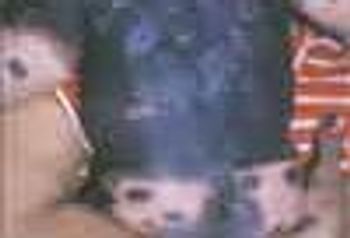
Two examples of polydactyly are shown. Photos A and B show a female newborn's right hand with an almost fully developed extra thumb; the radiograph shows what appears to be the distal phalanx bone of the extra digit.

Two examples of polydactyly are shown. Photos A and B show a female newborn's right hand with an almost fully developed extra thumb; the radiograph shows what appears to be the distal phalanx bone of the extra digit.

A thriving boy was brought to the office 3 weeks after his first birthday. His mother reported that there was "something wrong with his knee." On visual examination, the knee appeared perfectly normal. On palpation, however, a 4-cm linear induration was evident over the knee fat pad, just medial and distal to the patella. It appeared soft, crepitant, and associated with the skin. No tenderness was noted on palpation; the infant did not object to palpation of this density any more than to auscultation, otoscopy, or anthropometric measurements. No erythema, ecchymosis, or signs of trauma were evident near the lesion. The only possibly relevant history was that the child had spent his birthday at his grandmother's home in the Ukraine a month earlier. He was constantly with his mother during that time, and no trauma was ever reported.

Consultations & Comments: "Focus on Vaccines" Correction: MMR Never Contained Thimerosal

Eight-year-old girl with mass in midline of neck.Mass first noted about 6 months earlier. Patient is otherwise well; past health unremarkable. No symptoms ofhypothyroidism.

ABSTRACT: Because foreign-body aspiration can cause symptoms that mimic those of other respiratory conditions, a high index of suspicion is crucial in all children who have pneumonia, atelectasis, or wheezing with an atypical course--especially when these conditions are unresponsive to usual medical therapy. A history of choking can usually be elicited in a patient who has aspirated a foreign body: such a history should be sought when respiratory symptoms develop suddenly. However, the absence of a choking history does not rule out foreign-body aspiration. Moreover, patients may be asymptomatic initially. Normal radiographic findings do not exclude an aspirated foreign body. Bronchoscopy should be strongly considered when an aspirated foreign body is suspected, even if radiographic images show normal findings. Rigid bronchoscopy is the procedure of choice for removing aspirated foreign bodies in children. Prevention of foreign-body aspiration can be enhanced through anticipatory guidance of parents/caregivers and through continued product safety efforts.

A 17-year-old boy presents with a red, scaly rash on his trunk that began as a single lesion on his left flank. The generalized eruption had developed within 24 to 48 hours. The patient's father has psoriasis.

A 23-month-old girl was brought to the pediatrician's office by her mother who was concerned about "bulging down there." The child's mother reported that a "bump" had been present in the girl's diaper area since her birth and that it had been growing.

A 4-year-old girl presented with bilateral deviation of the fifth fingers. The deformity was noted in early childhood. There was no history of trauma or family history of a similar deformity. Physical examination was normal except for incurving of the fifth fingers.

This toddler has had abnormal-looking eyes since birth.What is this condition--and how common is it? Might this ocular malformation be associated with any other findings?

In recent years, adolescents have begun to turn to unconventional sources of drugs to abuse. One such drug that is becoming more and more popular among teenagers is dextromethorphan, a common ingredient in many cough and cold medications. In large doses, dextromethorphan is broken down into dextrorphan, which can produce euphoria and hallucinations--effects similar to those of phencyclidine

This 6-month-old boy was born with a pigmented hairy nevus that covered about 80% of his body surface. Multiple pigmented satellite lesions were also present.

Foreign-body aspiration is a relatively common occurrence in children. It may present as a life-threatening event that necessitates prompt removal of the aspirated material. However, the diagnosis may be delayed when the history is atypical, when parents fail to appreciate the significance of symptoms, or when clinical and radiologic findings are misleading or overlooked by the physician.